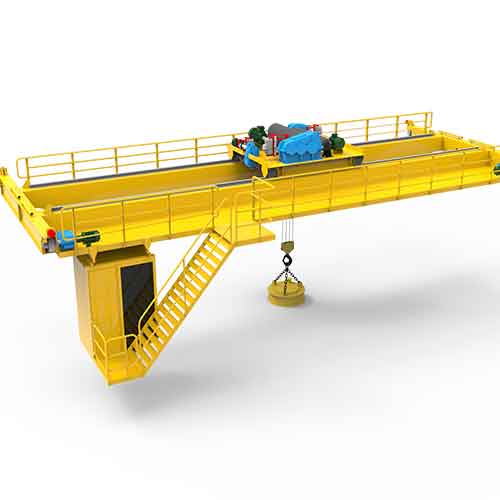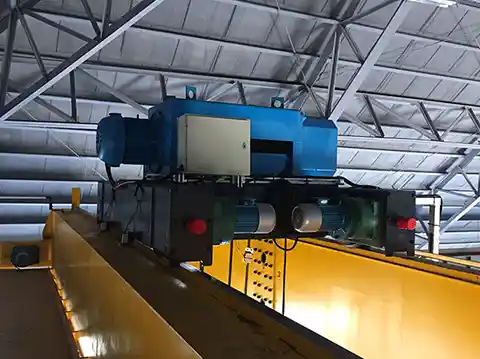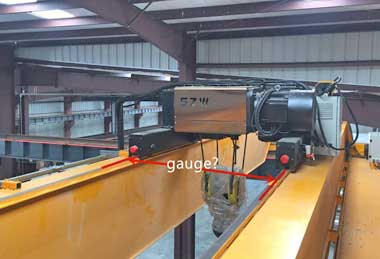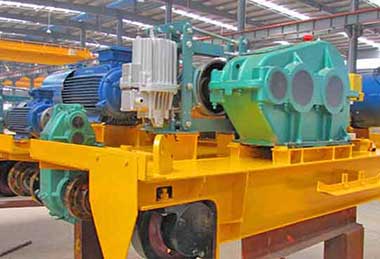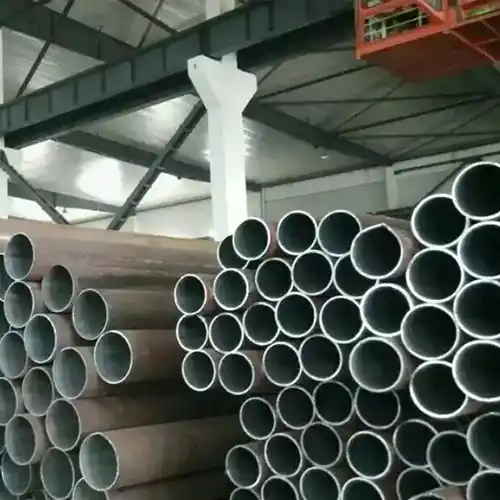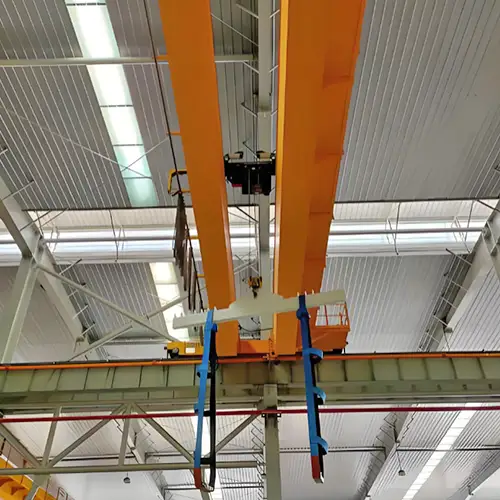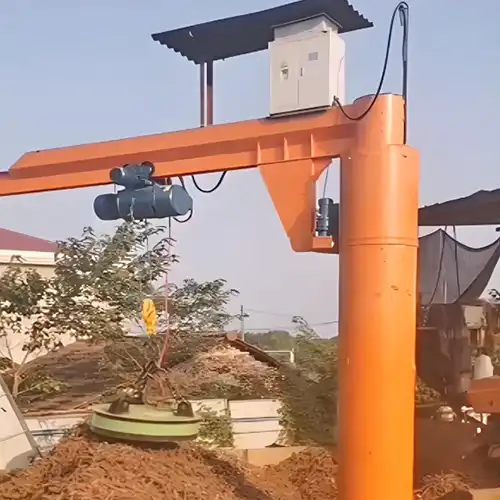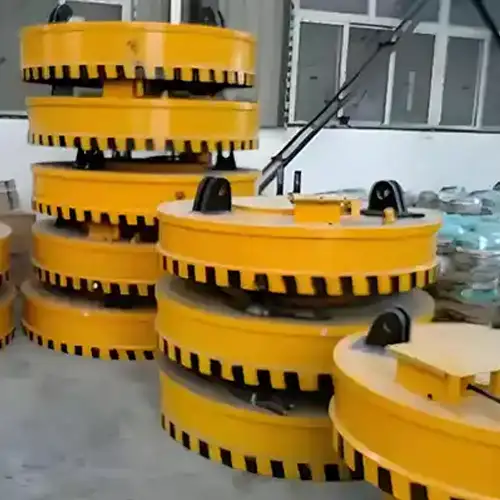How to Confirm Electromagnetic Overhead Crane Specifications for Your Needs
Confirm electromagnetic overhead crane specifications by assessing load capacity, lift height, operational environment, safety features&customization options to meet your specific needs.
Category: Magnetic Crane
Your Trusted Electromagentic Overhead Crane Manufacturer & Supplier
How to Confirm Electromagnetic Overhead Crane Specifications for Your Needs
Confirm electromagnetic overhead crane specifications by assessing load capacity, lift height, operational environment, safety features&customization options to meet your specific needs.
Electromagnetic cranes, also known as lifting magnets, utilize powerful electromagnets to lift and transport ferrous materials such as steel plates, bars, and scrap metal. Unlike traditional cranes, which rely on mechanical means for lifting, electromagnetic cranes offer a unique advantage: they can securely grip and release materials with precision and efficiency.
Now, you might be wondering, why is it so important to select the right Specifications for electromagnetic cranes? Well, the answer is simple: efficiency and safety. By tailoring the Specifications of your electromagnetic crane to match your specific application, you can ensure smooth and reliable operation while minimizing the risk of accidents or damage to materials.
Electromagnetic Crane and Cranes Specifications
Types of Electromagnetic Cranes
When it comes to electromagnetic cranes, there are several variations available, each designed to suit specific lifting requirements. Let's explore the different types based on their lifting mechanisms and power sources.
Types based on Lifting Mechanisms
Electromagnetic cranes can be classified based on their lifting mechanisms, which dictate how they lift and transport materials. The most common types include:
- Overhead Electromagnetic Cranes: These cranes are mounted on an overhead runway system, allowing them to move horizontally along a track while lifting and lowering materials vertically. They are commonly used in manufacturing facilities and warehouses for heavy-duty lifting operations.
- Gantry Electromagnetic Cranes: Gantry cranes feature a bridge-like structure supported by legs on either side, providing both lateral and vertical movement capabilities. They are ideal for outdoor applications such as shipyards, construction sites, and railway yards.
- Jib Electromagnetic Cranes: Jib cranes consist of a horizontal arm (jib) that can rotate around a vertical pillar or wall-mounted bracket. They offer a smaller footprint and are suitable for localized lifting tasks in workshops, loading docks, and assembly lines.
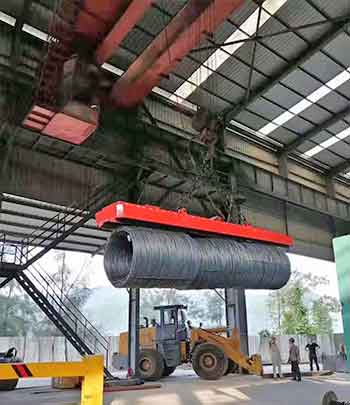
Electromagnetic Overhead Cranes:
Main Features:
Equipped with electromagnetic lifting systems that use electromagnets to attract and hold ferrous materials securely. Typically feature double girder configurations for increased lifting capacity and stability. Controlled via pendant or remote control for precise positioning and efficient material handling. Often equipped with safety features such as overload protection, emergency stop buttons, and limit switches.
Typical Loads Handled:
Ferrous materials such as steel plates, beams, pipes, and castings. Scrap metal, metal sheets, and other magnetic materials. Components for fabrication, assembly, and manufacturing processes.
Benefits:
Efficient Handling: Electromagnetic overhead cranes offer efficient handling of ferrous materials, allowing for quick and precise loading, unloading, and positioning. Increased Safety: The use of electromagnets ensures secure gripping of materials, reducing the risk of accidents due to load slippage or shifting. Versatility: These cranes can handle a wide range of loads, including irregularly shaped or unevenly distributed materials. Reduced Labor Costs: Automation of material handling tasks with electromagnetic cranes can lead to labor savings and increased productivity.
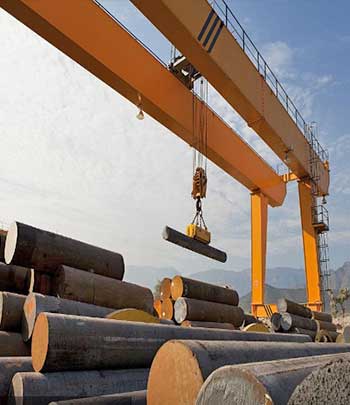
Electromagnetic Gantry Cranes:
Main Features:
Similar to overhead cranes, but supported by legs or posts on the floor rather than being suspended from a building structure. Equipped with electromagnetic lifting systems attached to the trolley for efficient material handling. Available in both single and double girder configurations to accommodate different lifting capacities and spans. Often used in outdoor environments such as shipyards, steel mills, and scrap yards.
Typical Loads Handled:
Large metal plates, sheets, coils, and billets. Structural steel sections, beams, and columns. Scrap metal, recycling materials, and bulk commodities.
Benefits:
Flexibility: Electromagnetic gantry cranes offer flexibility in material handling operations, allowing for efficient loading and unloading of ferrous materials in various environments. Mobility: These cranes can be easily relocated within the workspace using wheels or rails mounted on the legs, providing versatility in applications. High Productivity: The use of electromagnets enables fast and efficient material handling, leading to increased productivity and throughput. Durability: Constructed with robust materials and designed for heavy-duty applications, electromagnetic gantry cranes are durable and reliable even in harsh operating conditions.
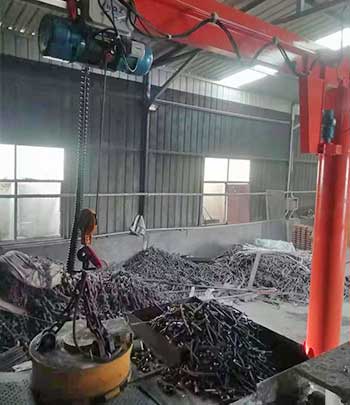
Electromagnetic Jib Cranes:
Main Features:
Compact and versatile crane systems mounted on a vertical mast or column, with a horizontal jib arm that rotates for flexible material handling. Equipped with electromagnetic lifting systems at the end of the jib arm for efficient lifting and maneuvering of ferrous materials. Typically used in confined workspaces or areas with limited overhead clearance. Available in various configurations, including wall-mounted, freestanding, and mobile options.
Typical Loads Handled:
Small to medium-sized metal components, tools, and equipment. Machined parts, castings, and forgings. Workpieces for welding, assembly, and fabrication processes.
Benefits:
Space-Saving Design: Electromagnetic jib cranes are ideal for maximizing floor space utilization in crowded work areas, as they require minimal footprint and overhead clearance. Precise Material Handling: The rotating jib arm allows for precise positioning of loads within the crane's operating radius, enhancing efficiency and productivity. Quick Installation: These cranes are relatively easy to install and can be quickly integrated into existing work environments with minimal disruption to operations. Ergonomic Operation: Electromagnetic jib cranes help reduce operator fatigue and strain by providing ergonomic lifting solutions for repetitive material handling tasks.
In summary, electromagnetic overhead cranes, gantry cranes, and jib cranes offer efficient, safe, and versatile solutions for handling ferrous materials in off-site fabrication yards and industrial environments. Their electromagnetic lifting systems provide secure gripping of materials, while their robust construction and advanced features ensure reliable performance and productivity gains.
Main Specifications of Electromagentic Overhead Bridge Cranes
| Technical Parameter of QC Electromagnetic Overhead Crane | ||||||||
| Capacity | t | 5 | 10 | 16 | 20 | 32 | 50 | |
| Span | S(m) | 10.5~31.5 | 10.5~31.5 | 10.5~31.5 | 10.5~31.5 | 10.5~31.5 | 10.5~31.5 | |
| Lifting height | m | 6~16 | 6~16 | 6~16 | 6~16 | 6~18 | 6~16 | |
| Lifting speed | m/min | 15.5 | 13.3 | 13 | 9.7 | 9.5 | 7.8 | |
| Trolley speed | m/min | 37.2 | 37.4 | 40.1 | 40 | 37 | 31.3 | |
| Crane speed | m/min | 70.6 | 70.6 | 74.3 | 75.1 | 64.9 | 58.5 | |
| Work duty | A5~A7 | A5~A7 | A5~A7 | A5~A7 | A5~A7 | A5~A7 | ||
| Track type | P38 | P38 P43 | P43 | P43 | QU70 | QU80 | 5 | |
Basic Components of Electromagnetic Cranes
Electromagnetic cranes are sophisticated machines comprised of several essential components that work together to facilitate lifting and material handling operations. Let's take a closer look at these components:
Electromagnets:
Electromagnets are the heart of electromagnetic cranes. These powerful magnets are responsible for creating the magnetic force necessary to lift and transport ferrous materials. The electromagnet consists of a coil of wire wound around a ferrous core, such as iron or steel. When an electric current flows through the coil, it generates a magnetic field, causing the core to become magnetized. This magnetic force attracts ferrous materials, allowing the crane to securely grip and lift them.
Electromagnets come in various shapes and sizes to accommodate different lifting requirements. They can be round or rectangular in shape, with flat or concave surfaces depending on the type of materials being handled. The strength of the magnetic field can also be adjusted to suit the weight and size of the load.
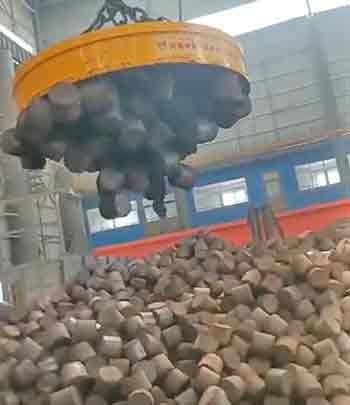
electromagnetic overhead crane

For underwater metal handling
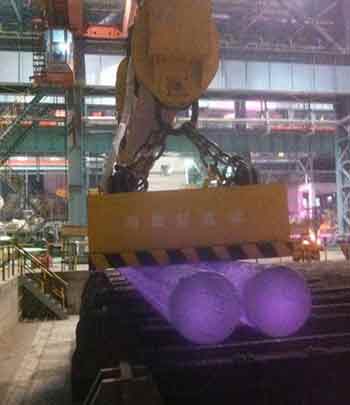
For hot metal handling
Lifting Mechanism:
The lifting mechanism is responsible for raising and lowering the load attached to the electromagnet. In electromagnetic cranes, the most common lifting mechanisms include hoists or winches, which are powered by electric motors.
Hoists consist of a drum or pulley system around which a wire rope or chain is wound. As the motor rotates the drum, the wire rope or chain is either wound up or unwound, lifting or lowering the load accordingly. Winches operate in a similar manner but are typically used for heavier loads and longer lifting heights.
The lifting mechanism is equipped with brakes and safety devices to ensure smooth and controlled lifting operations. Some electromagnetic cranes also feature variable speed controls, allowing for precise positioning of the load.
Control System:
The control system is the brain of the electromagnetic crane, governing its operation and movement. It consists of various components, including control panels, switches, and sensors, that enable operators to control the crane's movements remotely or from a centralized location.
Modern electromagnetic cranes are equipped with advanced control systems that offer features such as variable speed control, overload protection, and emergency stop functions. These systems enhance safety, efficiency, and productivity in material handling operations.
Additionally, some electromagnetic cranes may be integrated with automation systems or connected to a network for real-time monitoring and data analysis. This allows for optimized crane performance and predictive maintenance, reducing downtime and enhancing overall operational efficiency.
Key Specifications to Consider
When selecting an electromagnetic crane for your specific application, it's essential to consider several key Specifications to ensure optimal performance and safety. Let's explore each of these Specifications in more detail:
- Lifting Capacity: The lifting capacity of the electromagnetic crane refers to the maximum weight it can safely lift and transport. It's crucial to assess the weight of the heaviest loads you'll be handling and choose a crane with a lifting capacity that exceeds this weight. Overloading a crane can result in equipment damage, accidents, and potential injuries.
- Size and Weight of Loads: In addition to the maximum weight, consider the size and dimensions of the loads you'll be lifting. This includes the length, width, and height of the materials. Ensure that the electromagnetic crane's lifting mechanism, such as the electromagnet and lifting beam, can accommodate the size and shape of the loads without any interference or imbalance.
- Quantity of Loads: Determine the number of loads you'll need to lift and transport simultaneously or within a given timeframe. Some electromagnetic cranes are designed to handle multiple loads simultaneously, while others are better suited for single-load operations. Understanding your throughput requirements will help you select the appropriate crane configuration.
- Material Characteristics: Consider the characteristics of the materials you'll be handling, such as ferrous or non-ferrous metals, scrap metal, or steel coils. Certain materials may require specialized handling equipment or safety precautions. Additionally, assess factors like surface condition, temperature, and shape, as these can affect the gripping ability of the electromagnet.
- Environmental Factors: Evaluate the operating environment where the electromagnetic crane will be used. Factors such as temperature extremes, humidity, corrosive substances, and outdoor exposure can impact crane performance and longevity. Choose a crane with suitable environmental protection features, such as weatherproofing, corrosion-resistant coatings, and thermal insulation.
- Power Requirements: Determine the power source available at your facility and ensure it meets the requirements of the electromagnetic crane. Electric electromagnetic cranes require a reliable source of electricity, typically three-phase AC power. Consider factors such as voltage, frequency, and phase compatibility to prevent power supply issues and ensure smooth crane operation.
- Safety Features: Prioritize safety when selecting an electromagnetic crane by choosing a model with robust safety features and built-in safeguards. Look for features such as overload protection, emergency stop buttons, fail-safe braking systems, and audible alarms. Additionally, ensure that the crane complies with relevant safety standards and regulations to minimize the risk of accidents and injuries in the workplace.
By carefully considering these key Specifications, you can select the right electromagnetic crane for your specific application, ensuring efficient and safe material handling operations. Remember to consult with crane specialists or engineers to assess your requirements and identify the most suitable crane configuration for your needs.
Determining Electromagnetic Crane Specifications
Assessing Load Characteristics
Before selecting an electromagnetic crane, it's crucial to thoroughly assess the characteristics of the loads you'll be handling. Let's delve deeper into each aspect of load assessment:
- Size and Dimensions: The size and dimensions of the loads play a critical role in determining the suitability of an electromagnetic crane. Measure the length, width, and height of the materials to ensure they can be safely lifted and transported by the crane without exceeding its capacity or interfering with its operation. Consider factors such as irregular shapes, protrusions, or sharp edges that may affect the lifting process.
- Weight: The weight of the loads directly impacts the lifting capacity requirements of the electromagnetic crane. Determine the maximum weight of the heaviest loads you'll be handling and select a crane with a lifting capacity that exceeds this weight. Overloading a crane can lead to equipment failure, accidents, and workplace injuries, so it's essential to accurately assess the weight of the materials.
- Temperature: Consider the temperature of the materials being lifted, as extreme temperatures can affect the performance of the electromagnetic crane and the integrity of the materials. For example, lifting materials at high temperatures may require special heat-resistant coatings or insulation to protect the crane and prevent damage to the materials. Conversely, lifting materials at low temperatures may require additional precautions to prevent condensation or freezing.
- Material Composition: The composition of the materials being lifted is another crucial factor to consider when selecting an electromagnetic crane. Ferrous materials such as steel, iron, and magnetic alloys are suitable for lifting with electromagnetic cranes, as they can be attracted and securely gripped by the electromagnet. However, non-ferrous materials such as aluminum, copper, and brass are not magnetic and may require alternative lifting methods.
Additionally, consider the surface condition of the materials, as smooth and flat surfaces provide better contact and grip for the electromagnet. Rough or uneven surfaces may require specialized lifting attachments or modifications to ensure a secure grip.
By thoroughly assessing the size, weight, temperature, and composition of the loads, you can accurately determine the requirements for an electromagnetic crane that meets your specific lifting needs. This ensures safe, efficient, and reliable material handling operations in your industrial facility.
Analyzing Operational Requirements
Analyzing the operational requirements is essential to ensure that the chosen electromagnetic crane meets the demands of your specific application. Let's explore each aspect in detail:
- Frequency of Use: Consider how frequently the electromagnetic crane will be used in your operation. Assess whether it will be used intermittently for occasional lifts or continuously for high-volume material handling tasks. The frequency of use will influence the crane's design, durability, and maintenance requirements. For high-frequency applications, choose a crane with robust construction and reliable components to withstand frequent use without compromising performance or safety.
- Lifting Height: Determine the maximum height to which loads need to be lifted in your facility. The lifting height of the electromagnetic crane should exceed the tallest point at which materials need to be placed or stacked. Consider factors such as building height, overhead obstructions, and clearance requirements when selecting the crane's lifting height. Choose a crane with sufficient lifting height to ensure smooth and efficient material handling operations without the need for additional manual handling or repositioning.
- Speed and Efficiency: Evaluate the desired speed and efficiency of material handling operations in your facility. Determine the rate at which loads need to be lifted, transported, and positioned to meet production targets or customer demands. Choose an electromagnetic crane with variable speed controls and efficient lifting mechanisms to optimize productivity and minimize downtime. Consider factors such as acceleration, deceleration, and travel speed when selecting the crane's speed capabilities. Additionally, prioritize energy-efficient designs to reduce operating costs and environmental impact.
- Duty Cycle: Assess the expected duty cycle of the electromagnetic crane, which refers to the ratio of operating time to rest or maintenance time. Duty cycle classifications typically range from light-duty (intermittent use) to heavy-duty (continuous use). Determine the anticipated workload and operational hours per day to select a crane with an appropriate duty cycle rating. Choosing a crane with a duty cycle that matches your operational requirements ensures reliable performance, longevity, and minimal downtime due to maintenance or repairs.
By analyzing these operational requirements, you can effectively select an electromagnetic crane that aligns with your specific application needs, ensuring efficient, safe, and reliable material handling operations in your industrial facility.
Considering Environmental Conditions
When selecting an electromagnetic crane, it's crucial to consider the environmental conditions in which the crane will operate. Let's delve into each aspect in more detail:
- Indoor vs. Outdoor Operation: Determine whether the electromagnetic crane will be used indoors or outdoors. Indoor environments typically offer controlled conditions with stable temperatures and minimal exposure to the elements. In contrast, outdoor environments are subject to fluctuating temperatures, weather conditions, and exposure to moisture, dust, and debris. Choose a crane with suitable weatherproofing, corrosion-resistant coatings, and sealing to protect against environmental factors in outdoor settings. Additionally, consider factors such as wind loads, UV exposure, and seismic activity when selecting the crane's design and construction for outdoor operation.
- Temperature Range: Evaluate the temperature range of the operating environment where the electromagnetic crane will be used. Extreme temperatures, both hot and cold, can impact crane performance and longevity. For example, high temperatures may affect the efficiency of electrical components and cause overheating, while low temperatures can affect lubrication and mechanical components. Choose a crane with temperature-rated materials, insulation, and cooling or heating systems to ensure reliable operation within the expected temperature range.
- Corrosive or Hazardous Environments: Assess whether the operating environment contains corrosive substances, hazardous chemicals, or abrasive materials that could degrade or damage the crane over time. Corrosion-resistant materials, protective coatings, and sealed enclosures are essential features for cranes operating in corrosive or hazardous environments. Additionally, consider explosion-proof or intrinsically safe designs for environments with flammable gases, vapors, or dusts to minimize the risk of ignition and ensure operator safety.

Indoor overhead crane + electromagetnic chucks
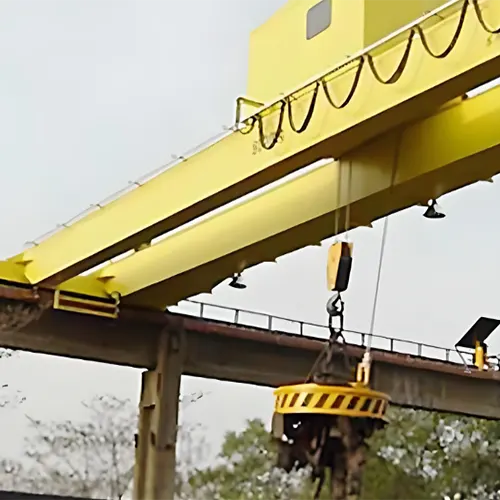
Oudoor overhead crane + electromagentic below hook devices
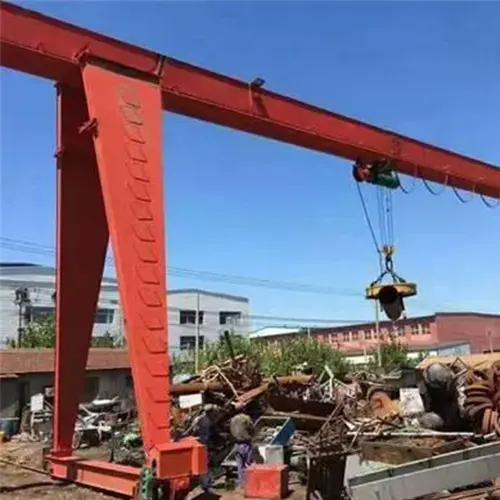
Ourdoor gantry cranes + electromagentic chucks
In summary, considering environmental conditions is critical when selecting an electromagnetic crane to ensure optimal performance, longevity, and safety in various operating environments. By evaluating factors such as indoor vs. outdoor operation, temperature range, and environmental hazards, you can choose a crane that meets the specific requirements of your application and provides reliable material handling capabilities in any environment.
Reviewing Power Supply and Control Options
When selecting an electromagnetic crane, it's essential to review the power supply and control options available to ensure compatibility with your facility's infrastructure and operational requirements. Let's explore each aspect in more detail:
- Voltage, Frequency, and Phase: Assess the voltage, frequency, and phase of the power supply available at your facility. Electromagnetic cranes typically require a stable and reliable source of electricity to operate effectively. Determine whether the crane's voltage, frequency, and phase specifications align with your facility's power supply to prevent compatibility issues. Additionally, consider factors such as voltage fluctuations, power surges, and electrical noise in the environment when selecting the crane's power requirements. Choose a crane with flexible voltage options or voltage regulation features to accommodate variations in the power supply.
- Control System Type (Manual vs. Automated): Consider the type of control system required for operating the electromagnetic crane. Manual control systems allow operators to control crane movements using pendant or push-button controls, providing direct and intuitive operation. Automated control systems, on the other hand, utilize advanced technology such as PLCs (Programmable Logic Controllers) and HMI (Human-Machine Interface) panels to automate crane movements, optimize productivity, and enhance safety. Determine whether manual or automated control systems are suitable for your application based on factors such as operator skill level, workload complexity, and safety requirements.
- Emergency Stop and Safety Features: Prioritize safety when selecting an electromagnetic crane by choosing a model with robust emergency stop and safety features. Emergency stop buttons allow operators to quickly halt crane movements in the event of an emergency or safety hazard, preventing accidents and injuries. Additionally, look for safety features such as overload protection, anti-collision systems, and proximity sensors to enhance crane safety and minimize the risk of accidents in the workplace. Ensure that the crane complies with relevant safety standards and regulations to maintain a safe working environment for operators and personnel.
In summary, reviewing power supply and control options is crucial when selecting an electromagnetic crane to ensure compatibility, reliability, and safety in your facility. By assessing factors such as voltage, frequency, phase, control system type, and safety features, you can choose a crane that meets your specific operational requirements and provides efficient and safe material handling capabilities.
Application of Electromagnetic Cranes in Various Industrial Sectors
Electromagnetic cranes find extensive applications across diverse industrial sectors, offering efficient and reliable material handling solutions. Let's explore their applications in detail:
- Manufacturing Industry: In the manufacturing industry, electromagnetic cranes play a vital role in handling raw materials, semi-finished products, and finished goods. They are used for lifting and transporting metal sheets, coils, bars, and components during production processes such as forging, casting, stamping, and machining. Electromagnetic cranes facilitate seamless material flow, improve productivity, and ensure precise positioning of materials on assembly lines and workstations.
- Construction Industry: In the construction industry, electromagnetic cranes are employed for lifting and moving heavy building materials such as steel beams, concrete panels, precast elements, and construction equipment. They are commonly used in construction sites, building projects, and infrastructure development to facilitate vertical and horizontal material transport, erection of structural elements, and assembly of prefabricated components. Electromagnetic cranes enhance construction efficiency, safety, and cost-effectiveness, enabling timely completion of projects.
- Mining and Quarrying: In the mining and quarrying industry, electromagnetic cranes are utilized for handling bulk materials such as ores, minerals, aggregates, and overburden. They are deployed in mining operations, open-pit mines, and quarries for loading and unloading trucks, stockpiling materials, and transferring ore between processing facilities. Electromagnetic cranes offer high lifting capacities, precise control, and adaptability to harsh operating environments, making them indispensable for efficient material handling in the mining sector.
- Shipbuilding and Marine Industry: In the shipbuilding and marine industry, electromagnetic cranes are essential for lifting and positioning heavy ship components, equipment, and modules during ship construction, repair, and maintenance activities. They are used in shipyards, dry docks, and port facilities for hoisting ship sections, engines, propellers, and shipyard machinery. Electromagnetic cranes facilitate safe and efficient handling of oversized and irregularly shaped loads, contributing to the timely completion of shipbuilding projects and vessel maintenance operations.
- Recycling and Scrap Yards: In the recycling and scrap yards, electromagnetic cranes are employed for sorting, loading, and processing various types of recyclable materials such as metal scrap, ferrous and non-ferrous metals, and industrial waste. They are used in recycling facilities, scrap metal yards, and material recovery plants for lifting and moving scrap metal bales, shredded materials, and bulky waste items. Electromagnetic cranes enable efficient material separation, recycling, and resource recovery, promoting sustainability and environmental stewardship.
- Warehousing and Logistics: In warehousing and logistics operations, electromagnetic cranes are utilized for handling palletized goods, containers, and heavy machinery in storage facilities, distribution centers, and ports. They are deployed for loading and unloading trucks, stacking and destacking pallets, and transferring goods between storage racks and transport vehicles. Electromagnetic cranes optimize warehouse space utilization, streamline inventory management, and expedite order fulfillment processes, enhancing overall supply chain efficiency and customer satisfaction.
In summary, electromagnetic cranes play a pivotal role in various industrial sectors, offering versatile and efficient material handling solutions that contribute to increased productivity, safety, and profitability. Their widespread applications across manufacturing, construction, mining, shipbuilding, recycling, and logistics underscore their importance in facilitating the movement and processing of materials in modern industrial operations.
Electromagnetic Cranes for Handling Different Types of Loads
When categorizing electromagnetic cranes based on the typical load they handle, several distinct types emerge, each tailored to specific industrial needs. Let's delve into these types:
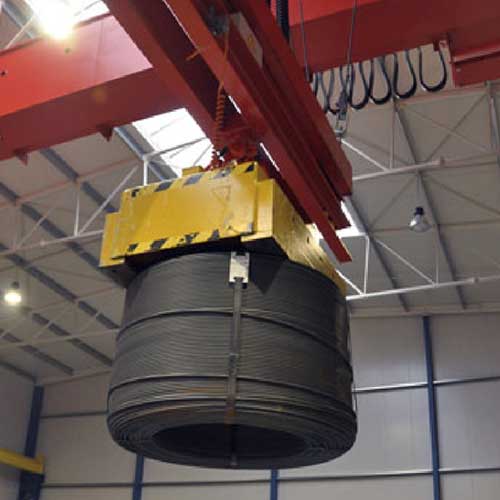
Steel Coil Handling Cranes:
These cranes are designed specifically for lifting and transporting steel coils within manufacturing plants, steel mills, and metal processing facilities. They feature specialized lifting attachments, such as coil hooks or C-hooks, that securely grip and handle steel coils of varying sizes and weights. Steel coil handling cranes are essential for efficiently moving coils from storage areas to processing machinery, such as rolling mills or stamping presses, with precision and reliability.
Steel Coil Sizes and Characteristics Required for Confirming Specifications
When requesting electromagnetic overhead cranes for handling steel coils, it's crucial to confirm the sizes of the steel coils to ensure that the crane's specifications align with the requirements of your operation. Here are the key details to consider:
- Coil Width: Measure the width of the steel coils, which refers to the distance across the coil from one edge to the other. This dimension is critical for determining the capacity and size of the lifting attachments, such as coil hooks or C-hooks, used by the crane to grip the coils securely. Ensure that the crane's lifting capacity and hook size are compatible with the widest steel coils in your inventory.
- Coil Diameter: Determine the diameter of the steel coils, which refers to the measurement across the coil's circular cross-section. Coil diameter plays a significant role in determining the clearance required between the crane's lifting attachments and the surrounding structures or machinery. It also influences the design of the crane's lifting mechanism and the positioning of the electromagnets or gripping devices for efficient coil handling.
- Coil Weight: Calculate the weight of the steel coils, which refers to the mass of the coil when fully loaded. Coil weight directly impacts the lifting capacity requirements of the electromagnetic overhead crane. Ensure that the crane's rated lifting capacity exceeds the maximum weight of the heaviest steel coils in your inventory to prevent overloading and ensure safe material handling operations.
- Coil Thickness: Determine the thickness of the steel coils, which refers to the measurement of the steel gauge or thickness of the metal sheet. Coil thickness affects the gripping and lifting capabilities of the crane's electromagnets or lifting attachments. Thicker coils may require stronger magnetic forces or larger gripping surfaces to ensure secure handling and prevent slippage during lifting and transportation.
- Coil Length: Measure the length of the steel coils, which refers to the distance from one end of the coil to the other. Coil length influences the spacing between individual coils during storage, stacking, and transportation. It also determines the clearance required between the crane's lifting attachments and the ground or other structures when lifting and maneuvering the coils within the facility.
By confirming these key details about the steel coil sizes, you can provide accurate specifications to crane manufacturers or suppliers to ensure that the electromagnetic overhead crane is designed and configured to meet the specific requirements of your operation. This proactive approach helps optimize material handling efficiency, enhance safety, and minimize downtime in your facility.
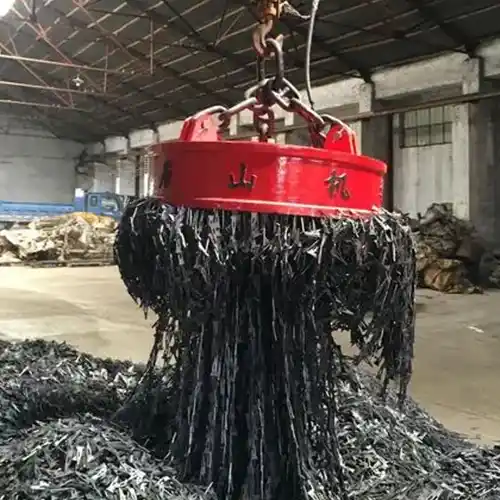
Scrap metal handling cranes are engineered to handle various types of scrap metal, including ferrous and non-ferrous materials, in recycling facilities, scrap yards, and metal processing plants. Equipped with powerful electromagnets or grappling attachments, these cranes can lift and transport bulky scrap metal items, such as automobile bodies, appliances, and structural steel, with ease. Scrap metal handling cranes play a crucial role in sorting, compacting, and processing scrap materials for recycling and reuse, contributing to sustainable waste management practices.
Scrap Metal Sizes and Characteristics Required for Confirming Specifications
When requesting a quotation for electromagnetic or electromagnetic cranes to handle scrap metal, it's essential to provide detailed information about the sizes and characteristics of the scrap metal to ensure that the crane meets the specific requirements of your operation. Here are the key details to consider:
- Metal Type: Identify the type of scrap metal to be handled, whether it is ferrous (containing iron) or non-ferrous (not containing iron). Ferrous metals include steel, iron, and alloys such as stainless steel, while non-ferrous metals include aluminum, copper, brass, and lead. The type of metal influences the design and configuration of the electromagnetic crane, particularly the strength and type of electromagnets required for lifting and transporting the scrap metal effectively.
- Metal Size and Shape: Provide information about the size, shape, and dimensions of the scrap metal pieces to be handled by the crane. This includes the length, width, and height of the metal objects, as well as any irregularities or protrusions that may affect the gripping and lifting process. Additionally, specify whether the scrap metal is in the form of loose pieces, bundles, coils, sheets, or other configurations to help determine the appropriate lifting attachments and electromagnet configurations.
- Metal Weight: Calculate the weight of the scrap metal pieces, which refers to the mass of the metal objects when fully loaded. Metal weight is a crucial factor in determining the lifting capacity requirements of the electromagnetic crane. Ensure that the crane's rated lifting capacity exceeds the maximum weight of the heaviest scrap metal pieces in your operation to prevent overloading and ensure safe material handling operations.
- Metal Condition: Assess the condition of the scrap metal, including factors such as cleanliness, corrosion, contamination, and temperature. Clean and dry scrap metal is easier to handle and less prone to issues such as slippage or damage during lifting and transportation. Contaminated or corroded metal may require special handling considerations or additional cleaning processes to prevent damage to the crane's electromagnets and lifting attachments.
- Environmental Conditions: Consider the operating environment where the electromagnetic crane will be used, including factors such as temperature, humidity, dust, and debris. Environmental conditions can affect the performance and longevity of the crane's electromagnets, control systems, and structural components. Choose electromagnet configurations and crane designs that are suitable for the specific environmental conditions in your facility to ensure reliable and efficient operation.
By providing detailed information about the sizes and characteristics of the scrap metal, you can request an accurate quotation for electromagnetic or electromagnetic cranes that are tailored to meet the specific requirements of your scrap handling operation. This proactive approach helps ensure optimal material handling efficiency, safety, and productivity in your facility.
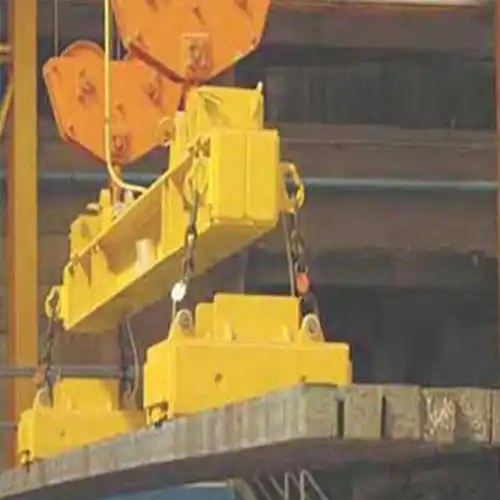
Billet and Bar Handling Cranes:
Billet and bar handling cranes are specialized cranes used in steel mills, foundries, and forging facilities to handle long and heavy metal bars, billets, and ingots. These cranes feature lifting attachments, such as spreader beams or tong grabs, designed to securely grip and transport metal bars of varying lengths and diameters. Billet and bar handling cranes facilitate the efficient movement of raw materials and semi-finished products between storage areas, processing machinery, and production lines, ensuring smooth and uninterrupted manufacturing operations.
Billet and Bar Sizes and Characteristics Required for Confirming Specifications
Billet and bar sizes and charateristics needed for quoation electromagenet or electromagetic cranes
When requesting a quotation for electromagnetic or electromagnetic cranes to handle billets and bars, it's essential to provide detailed information about the sizes and characteristics of the materials to ensure that the crane meets the specific requirements of your operation. Here are the key details to consider:
- Billet and Bar Dimensions: Provide information about the dimensions of the billets and bars to be handled by the crane. This includes the length, width, and height or diameter of the billets and bars. Additionally, specify any irregularities or protrusions that may affect the gripping and lifting process, such as chamfered edges or rough surfaces. Accurate dimensions help determine the appropriate lifting attachments and electromagnet configurations for efficient material handling.
- Billet and Bar Weight: Calculate the weight of the billets and bars, which refers to the mass of the metal objects when fully loaded. Billet and bar weight are crucial factors in determining the lifting capacity requirements of the electromagnetic crane. Ensure that the crane's rated lifting capacity exceeds the maximum weight of the heaviest billets and bars in your operation to prevent overloading and ensure safe material handling operations.
- Material Composition: Identify the material composition of the billets and bars, including the type of metal and any alloying elements present. Common materials handled by electromagnetic cranes in billet and bar applications include steel, aluminum, copper, and alloys such as brass and bronze. The material composition influences the strength and type of electromagnets required for lifting and transporting the billets and bars effectively.
- Surface Condition: Assess the surface condition of the billets and bars, including factors such as cleanliness, surface finish, and temperature. Clean and dry surfaces facilitate secure gripping and lifting, while surface contaminants or scale may affect the performance of the electromagnets and lifting attachments. Additionally, consider the temperature of the billets and bars, as elevated temperatures may require special handling considerations or heat-resistant materials for the crane's components.
- Handling Requirements: Determine the handling requirements for the billets and bars, including the frequency of lifts, stacking or stacking patterns, and positioning accuracy. Consider factors such as production throughput, material flow, and space constraints in the facility when specifying the crane's capabilities. Choose electromagnet configurations and crane designs that are suitable for the specific handling requirements of your billet and bar operations to ensure efficient and safe material handling operations.
By providing detailed information about the sizes and characteristics of the billets and bars, you can request an accurate quotation for electromagnetic or electromagnetic cranes that are tailored to meet the specific requirements of your material handling operation. This proactive approach helps ensure optimal productivity, safety, and reliability in your facility.
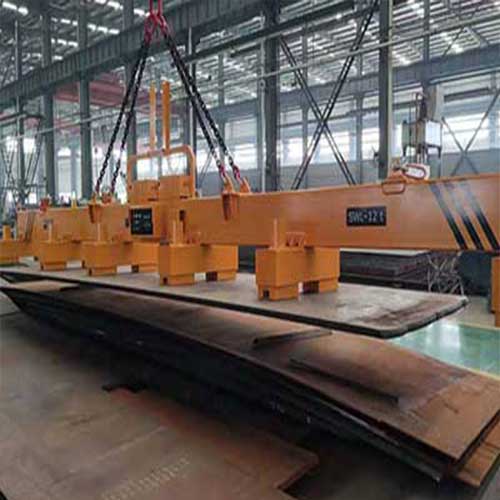
Plate and Sheet Handling Cranes:
Plate and sheet handling cranes are tailored for lifting and maneuvering large and heavy metal plates, sheets, and panels in metal fabrication shops, shipyards, and construction sites. These cranes are equipped with specialized lifting attachments, such as vacuum lifters or magnetic lifting beams, that provide secure and precise handling of flat metal materials. Plate and sheet handling cranes enable operators to safely position and transport metal plates for cutting, bending, welding, and assembly processes, contributing to efficient and accurate fabrication operations.
Plate and Sheet Sizes and Characteristics Required for Confirming Specifications
When requesting a quotation for electromagnetic or electromagnetic cranes to handle plates and sheets, it's essential to provide detailed information about the sizes and characteristics of the materials to ensure that the crane meets the specific requirements of your operation. Here are the key details to consider:
- Plate and Sheet Dimensions: Provide information about the dimensions of the plates and sheets to be handled by the crane. This includes the length, width, and thickness of the plates and sheets. Additionally, specify any irregularities or protrusions that may affect the gripping and lifting process, such as raised edges or surface textures. Accurate dimensions help determine the appropriate lifting attachments and electromagnet configurations for efficient material handling.
- Plate and Sheet Weight: Calculate the weight of the plates and sheets, which refers to the mass of the metal objects when fully loaded. Plate and sheet weight are crucial factors in determining the lifting capacity requirements of the electromagnetic crane. Ensure that the crane's rated lifting capacity exceeds the maximum weight of the heaviest plates and sheets in your operation to prevent overloading and ensure safe material handling operations.
- Material Composition: Identify the material composition of the plates and sheets, including the type of metal and any alloying elements present. Common materials handled by electromagnetic cranes in plate and sheet applications include steel, aluminum, copper, and alloys such as titanium and nickel. The material composition influences the strength and type of electromagnets required for lifting and transporting the plates and sheets effectively.
- Surface Condition: Assess the surface condition of the plates and sheets, including factors such as cleanliness, surface finish, and flatness. Clean and flat surfaces facilitate secure gripping and lifting, while surface contaminants or imperfections may affect the performance of the electromagnets and lifting attachments. Additionally, consider the temperature of the plates and sheets, as elevated temperatures may require special handling considerations or heat-resistant materials for the crane's components.
- Handling Requirements: Determine the handling requirements for the plates and sheets, including the frequency of lifts, stacking or stacking patterns, and positioning accuracy. Consider factors such as production throughput, material flow, and space constraints in the facility when specifying the crane's capabilities. Choose electromagnet configurations and crane designs that are suitable for the specific handling requirements of your plate and sheet operations to ensure efficient and safe material handling operations.
By providing detailed information about the sizes and characteristics of the plates and sheets, you can request an accurate quotation for electromagnetic or electromagnetic cranes that are tailored to meet the specific requirements of your material handling operation. This proactive approach helps ensure optimal productivity, safety, and reliability in your facility.
Steel pipes are ubiquitous in various industries, from construction to oil and gas. Handling these heavy and often bulky materials requires specialized equipment like steel pipe handling cranes. These cranes are designed to lift, transport, and position steel pipes safely and efficiently, contributing to smoother operations and improved workplace safety. When considering the specifications of steel pipe handling cranes, several factors related to the size and characteristics of the pipes must be taken into account to ensure optimal performance and safety.
Steel Pipe Sizes and Characteristics Required for Confirming Specifications
- Diameter and Wall Thickness:
Accurate measurements of the diameter and wall thickness of steel pipes are essential for determining the appropriate lifting capacity and configuration of the crane.
Larger diameter pipes and those with thicker walls will require cranes with higher lifting capacities and specialized lifting attachments to ensure secure handling.
Knowing the diameter and wall thickness also helps in selecting the appropriate lifting accessories, such as slings or clamps, to safely secure the pipes during lifting and transportation. - Length:
The length of steel pipes directly impacts the crane's lifting capacity, as longer pipes exert greater leverage and stress on the lifting system.
Crane specifications must account for the maximum length of steel pipes to be handled, considering factors such as overhang and sway during lifting and movement.
Longer pipes may require cranes with extended reach or specialized lifting configurations to ensure stability and prevent damage to the pipes or surrounding structures. - Weight and Load Distribution:
Steel pipes vary in weight depending on their size, material grade, and wall thickness. Crane specifications must account for the maximum weight of the heaviest pipes to be lifted.
Understanding the load distribution of steel pipes is crucial for determining the crane's lifting capacity and selecting appropriate lifting attachments.
Pipes with uneven weight distribution or off-center loads may require specialized lifting accessories or crane configurations to maintain stability and prevent accidents. - Material Composition:
Different grades of steel are used for various applications, each with its own mechanical properties and characteristics.
Crane specifications should consider the material composition of the steel pipes, including factors such as tensile strength, corrosion resistance, and ductility, to ensure safe and efficient handling.
Specialized lifting attachments or protective measures may be required for handling corrosive or abrasive materials to prevent damage to the crane and ensure the longevity of equipment. - Surface Condition and Handling Requirements:
The surface condition of steel pipes, including factors such as coatings, roughness, and surface treatment, can affect their handling characteristics.
Crane specifications should account for any special handling requirements associated with the surface condition of the pipes, such as the use of protective coatings or padding to prevent scratches or damage during lifting and transportation.
Handling requirements may also include considerations for stacking, bundling, or securing the pipes to pallets or racks, requiring cranes with specialized lifting configurations or accessories.
By considering these factors related to steel pipe sizes and characteristics, operators can accurately determine the specifications of steel pipe handling cranes required for their specific applications. This ensures safe, efficient, and reliable handling of steel pipes, contributing to enhanced productivity and workplace safety in industries where steel pipes are a vital component of operations.
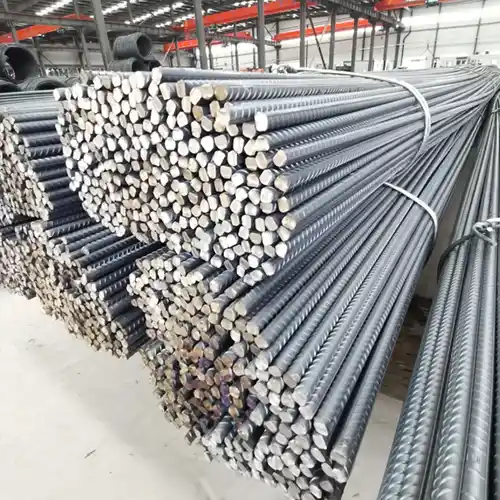
Rebar, short for reinforcing bar, is a critical construction material used to provide strength and stability to concrete structures. Handling rebar efficiently and safely requires specialized equipment like rebar handling cranes. These cranes are designed to lift, transport, and position rebar bundles with precision, contributing to faster construction processes and improved workplace safety. When determining the specifications of rebar handling cranes, several factors related to the size and characteristics of the rebars must be considered to ensure optimal performance and safety.
Rebar Sizes and Characteristics Required for Confirming Specifications
- Diameter and Length:
Rebars come in various diameters and lengths depending on the specific construction requirements.
Crane specifications must account for the maximum diameter and length of rebars to be handled, considering factors such as overhang and sway during lifting and movement.
Longer or thicker rebars may require cranes with higher lifting capacities and specialized lifting attachments to ensure secure handling and prevent bending or deformation during lifting. - Bundle Configuration:
Rebars are often bundled together for ease of handling and transportation.
Crane specifications should consider the configuration and size of rebar bundles, including factors such as the number of rebars per bundle and the spacing between rebars.
Handling bundled rebars may require cranes with specialized lifting attachments or configurations to ensure even weight distribution and prevent the bundle from shifting or tipping during lifting and movement. - Weight and Load Distribution:
The weight of rebars varies depending on their diameter, length, and material composition.
Crane specifications must account for the maximum weight of rebar bundles to be lifted, considering factors such as the number of rebars per bundle and their distribution.
Rebars with uneven weight distribution or off-center loads may require specialized lifting accessories or crane configurations to maintain stability and prevent accidents. - Material Composition:
Rebars are typically made of carbon steel or stainless steel, each with its own mechanical properties and characteristics.
Crane specifications should consider the material composition of the rebars, including factors such as tensile strength, yield strength, and corrosion resistance, to ensure safe and efficient handling.
Specialized lifting attachments or protective measures may be required for handling corrosive or abrasive materials to prevent damage to the crane and ensure the longevity of equipment. - Surface Condition and Handling Requirements:
The surface condition of rebars, including factors such as rust, coatings, and surface treatment, can affect their handling characteristics.
Crane specifications should account for any special handling requirements associated with the surface condition of the rebars, such as the use of protective coatings or padding to prevent scratches or damage during lifting and transportation.
Handling requirements may also include considerations for stacking, bundling, or securing the rebars to pallets or racks, requiring cranes with specialized lifting configurations or accessories.
By considering these factors related to rebar sizes and characteristics, operators can accurately determine the specifications of rebar handling cranes required for their specific construction projects. This ensures safe, efficient, and reliable handling of rebars, contributing to enhanced productivity and workplace safety in the construction industry.
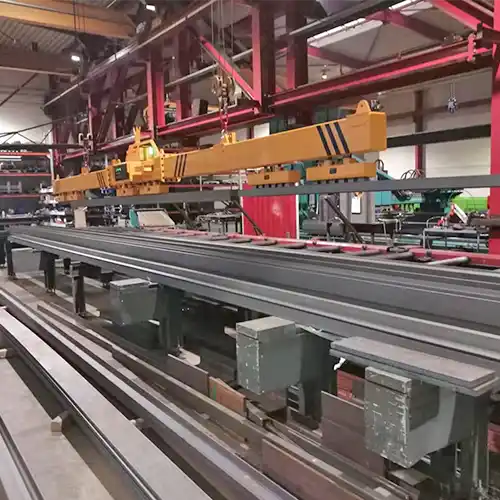
Steel profile handling cranes are essential equipment in industries such as construction, manufacturing, and steel fabrication, where steel profiles, such as beams, channels, angles, and tubes, are commonly used. These cranes are designed to lift, transport, and position steel profiles with precision, contributing to efficient material handling processes and improved workplace productivity. When determining the specifications of steel profile handling cranes, several factors related to the size and characteristics of the steel profiles must be considered to ensure optimal performance and safety.
Steel Profile Sizes and Characteristics Required for Confirming Specifications
- Type of Steel Profiles:
Steel profiles come in various shapes and sizes, including beams, channels, angles, tubes, and custom profiles.
Crane specifications must account for the specific types of steel profiles to be handled, as different profiles may require different lifting attachments or configurations. - Size and Dimensions:
Steel profiles vary in size and dimensions, with differences in length, width, height, and weight.
Crane specifications should consider the maximum size and dimensions of the steel profiles to be lifted, ensuring that the crane's lifting capacity and reach are sufficient for handling the largest and heaviest profiles. - Weight and Load Distribution:
Steel profiles come in various weights depending on their size, thickness, and material grade.
Crane specifications must account for the maximum weight of steel profiles to be lifted, considering factors such as the distribution of weight within the load and the stability of the crane during lifting and movement. - Material Composition:
Steel profiles are typically made of carbon steel or alloy steel, each with its own mechanical properties and characteristics.
Crane specifications should consider the material composition of the steel profiles, including factors such as tensile strength, yield strength, and corrosion resistance, to ensure safe and efficient handling. - Handling Requirements:
Steel profiles may require special handling procedures, such as stacking, bundling, or positioning.
Crane specifications should account for any special handling requirements associated with the steel profiles, ensuring that the crane is equipped with the necessary attachments or features to accommodate these processes. - Environmental Conditions:
Steel profile handling cranes may operate in various environmental conditions, including indoor and outdoor settings, as well as harsh environments such as steel mills or fabrication shops.
Crane specifications should consider the environmental conditions, including factors such as temperature extremes, dust, moisture, and corrosive substances, to ensure that the crane is designed to withstand these challenges and maintain reliable performance over time.
By considering these factors related to steel profile sizes and characteristics, operators can accurately determine the specifications of steel profile handling cranes required for their specific material handling applications. This ensures safe, efficient, and reliable handling of steel profiles, contributing to enhanced productivity and workplace safety in industries where steel profiles are a fundamental component of operations.
Each type of electromagnetic crane is tailored to handle specific types of loads efficiently and safely, contributing to seamless material handling operations in various industrial sectors. By selecting the appropriate crane type for your application, you can optimize productivity, enhance safety, and maximize operational efficiency in your facility.
Case Studies and Examples
Case Study 1: Electromagnetic Crane Selection for Steel Manufacturing Plant
In this case study, a steel manufacturing plant sought to upgrade its material handling equipment to improve efficiency and productivity. The plant required electromagnetic cranes capable of lifting and transporting heavy steel coils, billets, and sheets within the production facility. After assessing the plant's requirements, including lifting capacity, lifting height, and operational environment, a custom-designed electromagnetic crane system was proposed. The crane system featured high-capacity electromagnets, variable speed controls, and advanced safety features to ensure safe and efficient material handling operations. The installation of the electromagnetic cranes resulted in increased throughput, reduced downtime, and improved safety in the steel manufacturing plant.
Case Study 2: Electromagnetic Crane Specifications for Scrap Metal Recycling Facility
In this case study, a scrap metal recycling facility needed to upgrade its material handling equipment to handle a wide range of ferrous and non-ferrous materials efficiently. The facility required electromagnetic cranes capable of lifting heavy metal scrap, shredded materials, and bulky waste items from trucks and sorting them for processing. After evaluating the facility's requirements, including load characteristics, environmental conditions, and operational demands, a customized electromagnetic crane solution was proposed. The crane system featured high-powered electromagnets, corrosion-resistant construction, and automated control systems to streamline material sorting and processing operations. The installation of the electromagnetic cranes improved material handling efficiency, reduced labor costs, and enhanced overall productivity in the scrap metal recycling facility.
Parameter Needed for Magnetic Overhead Cranes Quoation
When specifying the basic Specifications for magnetic cranes, it is crucial to ensure that the crane and its electromagnets are compatible with the operational needs and safety requirements of your facility. Here are the key details to consider:
Basic Specifications of Magnetic Cranes Needed for Quotation
Crane Types:_______?
Overhead Cranes:These cranes consist of parallel runways with a traveling bridge spanning the gap. They are commonly used in manufacturing, warehousing, and maintenance applications. Application: Suitable for lifting and transporting heavy materials across large, open areas.
- Gantry Cranes: Description: Gantry cranes are similar to overhead cranes but are supported by legs that move on rails or wheels. They can be used indoors or outdoors. Application: Ideal for heavy lifting operations in shipyards, construction sites, and container yards.
- Jib Cranes: Jib cranes have a horizontal arm (jib) that supports a hoist, which can move along the length of the ji They are often mounted on a wall or floor. Application: Commonly used for localized lifting tasks in workshops, assembly lines, and smaller industrial environments.
- Other Types:
Crane Capacity:_______?
The maximum weight that the crane can safely lift and move.
Considerations:
Ensure that the crane's lifting capacity exceeds the heaviest load expected in your operations.
Factor in the weight of the electromagnet and any attachments when calculating the total lifting load.
Choose a crane with a margin of safety to account for unexpected weight variations or dynamic forces.
Lifting Height:_______?
The maximum vertical distance that the crane can lift a load from the ground or floor level.
Considerations:
Determine the required lifting height based on the operational needs, including the height of storage racks, processing equipment, or loading platforms.
Ensure the crane can lift the load to the highest required point without exceeding its design limits.
Consider the available headroom in the facility, especially if the crane operates indoors.
Crane Span:_______?
Definition: The distance between the crane's runways (for overhead cranes) or the supporting legs (for gantry cranes).
Considerations:
Measure the span required to cover the working area where materials need to be lifted and moved.
Ensure the crane's span matches the width of the workspace and any obstructions, such as walls or machinery.
For gantry cranes, consider the rail or track layout to ensure smooth and efficient movement across the span.
Additional Considerations:
- Power Supply:_______?
Ensure the crane's power supply is compatible with the facility's electrical system (e.g., 380V, 50Hz, 3Phase). Verify that the power supply can support the electromagnets' requirements, especially if using multiple magnets simultaneously. - Control System:_______?
Choose between manual or automated control systems based on the complexity and precision required for the lifting tasks. Include emergency stop features and safety interlocks to protect operators and equipment. - Safety Features:_______?
Implement overload protection, limit switches, and anti-collision systems to enhance operational safety. Regularly inspect and maintain the crane and electromagnets to ensure they function correctly and safely.
By carefully considering these Specifications and ensuring they match the specific needs of your operation, you can select the appropriate magnetic crane system to optimize efficiency, safety, and reliability in material handling tasks.
How to Confirm the Proper Electromagnet Paarameres and Specifications Required for Your Needs?
When specifying electromagnetic cranes for material handling, understanding and providing detailed information about key Specifications ensures the correct selection and optimal performance of the system. Here's an in-depth look at the critical factors to consider:
1. Size of the Material to be Magnetized
Length, Width, and Height: _______?
- Importance:
Accurate Measurements: Precise measurements of the length, width, and height of the materials ensure that the electromagnets can cover the necessary surface area to generate a strong magnetic hold. This is particularly important for large, flat materials such as steel plates, which require uniform magnetic force distribution across their entire surface.
Selection of Electromagnets: Knowing the dimensions helps in selecting the appropriate size and number of electromagnets. For example, a single large electromagnet might be suitable for smaller materials, whereas multiple electromagnets arranged in a specific pattern might be necessary for larger items. - Examples:
Steel Plates: If the steel plates are 4 meters long, 2 meters wide, and 0.5 centimeters thick, these dimensions will determine the size and number of electromagnets needed to lift the plate without bending or dropping it.
Steel Coils: For steel coils, knowing the length of the coil when unrolled and the width and thickness of the material helps in configuring the electromagnets to lift the coil safely without unwinding or deforming it.
Diameter and Thickness_______?
- Importance:
- Cylindrical Objects: For cylindrical objects like pipes, bars, and rods, providing the diameter and wall thickness is essential. These dimensions ensure that the electromagnet's magnetic field strength is sufficient to securely lift and hold the material.
Magnetic Field Strength: The electromagnet must generate a magnetic field strong enough to penetrate the entire thickness of the material and provide a stable lift. For thicker materials, more powerful magnets or different configurations might be necessary. - Examples:
- Pipes: If lifting steel pipes with a diameter of 30 centimeters and a wall thickness of 2 centimeters, these dimensions help determine the appropriate electromagnet strength and configuration to grip the pipe securely without slipping.
Bars and Rods: For steel bars that are 3 meters long with a diameter of 10 centimeters, the electromagnets must be configured to handle the bar's weight and length without causing damage or instability during lifting.
Practical Considerations
- Distribution of Magnetic Force:
- Uniform Force Application: Ensuring that the magnetic force is evenly distributed across the surface of the material prevents deformation, especially for thin or delicate materials. This is crucial for maintaining the integrity and quality of the materials during handling.
Avoiding Material Damage: Proper dimension specifications prevent excessive magnetic force concentration on a small area, which can cause dents, warping, or other forms of damage. - Configuration of Electromagnets:
- Single vs. Multiple Magnets: Depending on the size and shape of the materials, multiple smaller magnets might be more effective than a single large magnet. This configuration allows for better weight distribution and stability.
Custom Shapes and Sizes: In some cases, custom-shaped electromagnets may be necessary to accommodate irregularly shaped materials or to provide better lifting performance for specific applications.
Providing detailed and accurate measurements of the length, width, height, diameter, and thickness of the materials to be lifted by electromagnetic cranes is essential for selecting the right equipment. These dimensions directly influence the type, size, and configuration of electromagnets needed to ensure safe and efficient lifting operations. By considering these factors, you can optimize the performance of your material handling processes and avoid potential issues related to improper magnet selection.
2.Load Sizes Impact on Electromagnet Selection:
Type of Electromagnets: The dimensions of the materials influence whether you need rectangular, circular, or custom-shaped electromagnets. Larger and heavier materials may require multiple electromagnets arranged in a specific configuration to distribute the load evenly.
Size of Magnetic Chucks: The magnetic chuck's size must match the material's surface area to ensure a strong and stable hold. Larger materials or those with irregular shapes may require specialized chucks for effective handling.
Type of Electromagnets_______?
- Rectangular, Circular, or Custom-Shaped Electromagnets:
Rectangular Electromagnets: These are commonly used for handling flat and rectangular materials such as steel plates, sheets, and slabs. Their shape allows for maximum surface contact, ensuring a strong and stable hold.
Use Case: For lifting large steel plates, rectangular electromagnets can cover a substantial surface area, providing uniform magnetic force and preventing bending or flexing of the material.
Circular Electromagnets: Ideal for cylindrical and round objects like pipes, bars, and coils. Their circular shape ensures an even distribution of magnetic force around the perimeter of the object.
Use Case: When lifting steel coils or cylindrical bars, circular electromagnets can securely grip the curved surfaces, ensuring stable and safe transportation.
Custom-Shaped Electromagnets: For irregularly shaped materials or specific lifting requirements, custom-shaped electromagnets are designed to match the contours of the load. This customization ensures optimal contact and magnetic force distribution.
Use Case: Handling uniquely shaped machine parts or fabricated metal pieces that do not fit standard geometries. - Multiple Electromagnets for Larger Loads:
Load Distribution: For larger and heavier materials, a single electromagnet may not provide sufficient lifting power or stability. Multiple electromagnets can be arranged in a configuration that evenly distributes the load's weight.
Use Case: A spreader beam equipped with multiple electromagnets can lift large steel sheets or bundles of pipes, distributing the magnetic force across the entire load to prevent deformation or slipping.
Enhanced Stability: Using multiple magnets reduces the risk of tipping or shifting during lifting operations, as the magnetic force is applied uniformly across the load's surface.
Use Case: In construction sites, lifting long steel beams with multiple electromagnets ensures that the beam remains level and secure, facilitating safer handling and placement.
Size of Magnetic Chucks
- Matching Surface Area:
Surface Area Considerations: The size of the magnetic chuck must align with the surface area of the material being lifted. A chuck that is too small may not generate enough magnetic force, leading to an unstable grip.
Use Case: For lifting wide steel plates, the magnetic chuck should cover as much of the plate's surface as possible to provide a strong hold and minimize the risk of dropping.
Material Shape and Size: Larger materials or those with irregular shapes often require specialized magnetic chucks designed to accommodate their specific dimensions and contours.
Use Case: Custom magnetic chucks for irregularly shaped metal castings ensure that the magnetic force is evenly distributed, securing the load effectively without causing damage. - Specialized Chucks for Effective Handling:
Custom Chucks for Irregular Shapes: When dealing with materials that have unique shapes or varying dimensions, specialized chucks are essential for ensuring a secure lift. These chucks are designed to fit the material's contours, maximizing contact and magnetic force.
Use Case: In manufacturing facilities, handling components with complex geometries using custom magnetic chucks ensures precise and safe lifting, reducing the risk of damage during transport.
Enhanced Contact and Force Distribution: Specialized magnetic chucks provide better contact with the material's surface, enhancing the stability and strength of the magnetic hold.
Use Case: For transporting large metal assemblies, customized magnetic chucks ensure that each part of the assembly is securely held, preventing movement or separation during lifting operations.
The dimensions of the materials being lifted play a critical role in determining the appropriate type and size of electromagnets and magnetic chucks. By considering factors such as the material's length, width, height, diameter, and thickness, you can select electromagnets and chucks that provide optimal contact and magnetic force distribution. This careful selection process ensures safe, stable, and efficient lifting operations, minimizing the risk of material damage and enhancing overall handling performance.
3. Quantity of Loads to be Handled_____?
Number of Pieces or Bundles:
Single vs. Multiple Pieces: Determine whether the crane needs to lift single items or multiple pieces simultaneously. For example, lifting a single large steel plate requires different considerations than lifting multiple small bundles of rebar.
Bundling Requirements: If handling bundles, provide details on the bundling method and the number of items per bundle. This helps in configuring the electromagnets to lift the entire bundle securely.
Single vs. Multiple Pieces
Determining the Lifting Requirement:
- Single Item Lifts:
- When the crane needs to lift single items, the focus is on ensuring that the electromagnet can securely grip and lift the individual item. This typically involves ensuring that the magnet's surface area and magnetic force are sufficient for the size and weight of the item.
Use Case: Lifting a single large steel plate. The electromagnet must be large enough and powerful enough to cover the plate's surface and lift it without bending or dropping.
Considerations: The magnet should be centrally placed to balance the load and avoid tipping. For very large or heavy plates, using multiple electromagnets in a coordinated manner might be necessary to ensure stability. - Multiple Pieces Lifts:
- Simultaneous Lifting: When lifting multiple pieces simultaneously, the configuration of the electromagnets becomes more complex. The goal is to ensure that each piece is securely held, preventing any from slipping or falling during the lift.
Use Case: Lifting multiple small bundles of rebar. The electromagnet system needs to be configured to grip each bundle securely.
Considerations: The magnets should be positioned to distribute the magnetic force evenly across all pieces. This might involve using a grid of smaller magnets rather than a single large magnet.
Bundling Requirements
- Details on Bundling Method:
Bundling Techniques: Understanding how the items are bundled is crucial. Different bundling methods (e.g., strapping, wiring, or packaging) affect how the electromagnets should be configured to lift the bundle securely.
Use Case: If the rebar is bundled with metal straps, the electromagnets should be positioned to avoid interfering with the straps while still gripping the rebar.
Considerations: Ensure that the magnetic force is sufficient to hold the entire bundle together. The bundling method should not impede the magnet's ability to secure the load.
Number of Items per Bundle:
- Specific Details: Providing the number of items per bundle helps in determining the total weight and the distribution of the load. This information is critical for configuring the electromagnets to handle the entire bundle effectively.
Use Case: If lifting bundles of steel pipes, knowing that each bundle contains ten pipes of a certain diameter and length allows for precise configuration of the magnets.
Considerations: The total weight of the bundle must be within the lifting capacity of the crane and the electromagnets. The arrangement of the pipes within the bundle should be such that the magnetic force is distributed evenly, preventing any single pipe from slipping out.
Practical Considerations
- Load Stability:
Securing Multiple Pieces: Ensuring that multiple items are securely held during the lift is crucial to prevent accidents. The electromagnets should be configured to provide uniform magnetic force across all items.
Use Case: For bundles of steel bars, ensure that each bar is gripped securely, and the bundle remains intact during lifting and transport.
Considerations: Use additional safety measures such as securing the load with additional straps or using multiple magnets to provide redundant holding points. - Configuration Flexibility:
Adjustable Systems: Using electromagnet systems that allow for adjustable positioning can accommodate different sizes and shapes of bundles. This flexibility is important for operations that handle various types of loads.
Use Case: In a warehouse that handles both single large sheets and bundles of smaller rods, an adjustable electromagnet system can switch between different configurations as needed.
Considerations: Ensure that the system can be easily reconfigured by the operators to match the specific lifting requirements of different loads.
The number of pieces or bundles that need to be lifted by electromagnetic cranes is essential for selecting and configuring the right electromagnets. Whether lifting single large items or multiple smaller pieces simultaneously, the specific requirements of each task must be considered to ensure safe and efficient operations. By providing detailed information on bundling methods and the number of items per bundle, you can configure the electromagnets to handle the loads securely, minimizing the risk of accidents and enhancing the efficiency of material handling processes.
4. Lifting Capacity and Configuration:_____?
Total Load Weight: The total weight of the materials to be lifted at once must be within the crane's lifting capacity. This includes the weight of the electromagnets and any additional lifting gear.
Electromagnet Arrangement: The number of loads influences the configuration of electromagnets. For example, handling multiple bundles may require a spreader beam with several smaller magnets instead of one large magnet.
Total Load Weight:
- Ensuring Safe Lifting Capacity:
Crane's Lifting Capacity: The total weight of the materials to be lifted must be within the crane's specified lifting capacity. This includes not just the load but also the weight of the electromagnets and any additional lifting gear used.
Use Case: If a crane is rated to lift 10 tons, and the load to be lifted weighs 8 tons, the combined weight of the electromagnets and any lifting accessories must not exceed the remaining 2 tons.
Considerations: Regularly check the crane's load capacity and ensure that the combined weight of the load and lifting equipment does not surpass this limit. Overloading the crane can lead to mechanical failure or accidents. - Calculation of Total Load Weight:
Load Weight Calculation: Accurately calculate the weight of the load, including any packaging or bundling materials. This ensures that the total weight is accounted for and within safe limits.
Use Case: When lifting a bundle of steel pipes, include the weight of any straps or pallets used in the bundling process.
Considerations: Use calibrated scales to weigh the load if possible, and keep records of the weights for reference in future lifting operations.
Electromagnet Arrangement
- Configuring Electromagnets for Multiple Loads:
Spreader Beam with Multiple Magnets: For lifting multiple bundles or large loads, a spreader beam equipped with several smaller electromagnets can provide better control and stability compared to a single large magnet.
Use Case: In a steel fabrication plant, lifting multiple bundles of rebar can be efficiently managed using a spreader beam with several smaller electromagnets, ensuring each bundle is securely held.
Considerations: The arrangement of the magnets should be such that the load is evenly distributed across all magnets, preventing any single magnet from being overloaded. - Uniform Magnetic Force Distribution:
Ensuring Even Load Distribution: The electromagnets should be arranged to provide uniform magnetic force across the entire load. This prevents uneven lifting and reduces the risk of load slippage.
Use Case: For a large steel plate, using multiple electromagnets positioned strategically along the length and width of the plate ensures even lifting and reduces bending.
Considerations: Adjustable magnet positioning allows for flexibility in handling different load sizes and shapes, enhancing the versatility of the lifting operation. - Special Configurations for Unique Loads:
Custom Electromagnet Configurations: Some loads may require custom configurations of electromagnets to ensure safe and effective lifting. This can include magnets of different shapes or sizes, or magnets arranged in specific patterns to accommodate irregularly shaped loads.
Use Case: Lifting large and irregularly shaped metal castings might require a combination of circular and rectangular electromagnets arranged to match the contours of the casting.
Considerations: Work with electromagnet manufacturers to design and implement custom configurations that meet the specific needs of your lifting operations.
Practical Considerations
- Safety Margins:
Incorporating Safety Margins: Always include a safety margin when calculating the total load weight. This ensures that unexpected weight variances or dynamic forces during lifting do not exceed the crane's capacity.
Use Case: If the total calculated load weight is 9.5 tons for a 10-ton capacity crane, include a safety margin and avoid operating at the maximum capacity continuously.
Considerations: Regular maintenance and inspection of the crane and electromagnets can help identify and mitigate potential risks associated with overloading. - Operational Efficiency:
Optimizing Load Handling: Efficiently configured electromagnets can enhance operational efficiency by reducing the time and effort required for load handling. Properly distributed loads lead to smoother and faster lifting operations.
Use Case: In a logistics center, using a spreader beam with multiple magnets to handle large batches of materials can speed up the loading and unloading process.
Considerations: Train operators on the optimal use of electromagnet configurations to maximize efficiency and ensure safe handling practices.
Accurately determining the lifting capacity and configuring the electromagnets appropriately are critical steps in ensuring safe and efficient lifting operations. By considering the total load weight, including all lifting gear, and arranging electromagnets to provide uniform magnetic force, you can optimize your lifting processes. Custom configurations and safety margins further enhance operational safety and efficiency, making electromagnetic cranes a versatile and reliable tool in various industrial applications.
5. Load Material Temperature_______?
Temperature Ranges: 0-150°C, 150-600°C , Above 600°C
Safety Considerations: Using the correct type of magnet based on temperature prevents accidents and equipment failure. High-temperature magnets are designed to withstand and operate efficiently in extreme conditions, ensuring the safety and reliability of lifting operations.
Temperature Ranges
- 0-150°C (Normal Temperature):
Standard Electromagnets: These are designed to lift materials within the 0-150°C temperature range without any special modifications. They are cost-effective and widely used in general industrial applications.
Use Case: Lifting steel plates, bars, or bundles that are stored at ambient or slightly elevated temperatures.
Considerations: Ensure the material's surface temperature does not exceed 150°C to avoid any reduction in magnetic efficiency or potential damage to the magnet's insulation and components. - 150-600°C (High Temperature):
High-Temperature Electromagnets: These magnets are specially designed to operate in environments where material temperatures range between 150-600° They are built with materials that can withstand higher temperatures without losing magnetic strength or becoming demagnetized.
Use Case: Handling hot steel billets, ingots, or parts directly from furnaces.
Considerations: Ensure proper cooling mechanisms are in place for the magnets and the crane's structural components to prevent overheating and maintain operational efficiency. - Above 600°C (Ultra-High Temperature):
Ultra-High Temperature Electromagnets: These are required for materials exceeding 600° These magnets are engineered with advanced materials and insulation to endure extreme heat, maintaining their performance and safety.
Use Case: Lifting red-hot metal directly from high-temperature industrial processes such as steelmaking.
Considerations: Regularly inspect and maintain these magnets to ensure they are in good condition, as operating at such high temperatures can accelerate wear and tear.
Safety Considerations_______?
- Using the Correct Type of Magnet:
Preventing Accidents: Employing the appropriate type of magnet based on the temperature of the materials is critical for safety. Incorrect magnet use can lead to demagnetization, loss of lifting force, or even catastrophic equipment failure.
Use Case: In a foundry, using high-temperature magnets for lifting hot castings prevents accidents and ensures smooth operation.
Considerations: Train operators to recognize temperature ranges and use the correct magnets. Implement protocols for regular temperature checks on loads before lifting. - Design and Material Resilience:
Material and Design Considerations: High and ultra-high temperature magnets are constructed with specialized materials that resist thermal degradation. This includes heat-resistant alloys and advanced insulation materials that maintain structural integrity and magnetic properties under extreme conditions.
Use Case: Handling continuously heated materials in a production line where temperatures frequently exceed normal ranges.
Considerations: Ensure that the crane and its lifting components, including cables and connectors, are also rated for high-temperature operation to prevent failure or accidents. - Operational Efficiency and Reliability:
Maintaining Performance: High-temperature environments can affect the performance and lifespan of electromagnets. Using the correct magnets ensures consistent lifting performance and reduces downtime due to equipment failure.
Use Case: In a steel mill, using appropriately rated magnets ensures that the lifting process remains efficient even at high operational temperatures.
Considerations: Regular maintenance schedules and temperature monitoring systems can help in early detection of potential issues, ensuring reliable and safe lifting operations. - Cooling and Maintenance:
Cooling Mechanisms: For high and ultra-high temperature operations, implementing cooling systems for the electromagnets and crane components can enhance performance and extend equipment lifespan.
Use Case: Using water-cooled or air-cooled systems in environments where magnets are exposed to prolonged high temperatures.
Considerations: Regularly check and maintain these cooling systems to ensure they are functioning correctly and providing adequate thermal regulation.
By understanding and addressing the temperature ranges of the materials being handled, operators can select the appropriate type of electromagnet, ensuring safe, efficient, and reliable lifting operations. This consideration is vital for maintaining the longevity and performance of both the electromagnets and the crane systems in high-temperature industrial environments.
6. Types of Magnetize Wires_______?
Wire Materials:1) Aluminum Wires: Cost-effective and commonly used in standard applications. They offer good performance for general lifting tasks.2) Copper Wires: Preferred for specific applications requiring higher electrical conductivity and efficiency, despite being more expensive. Copper wires are often used in situations where stronger and more consistent magnetic fields are needed.
Application-Specific Selection: The choice between aluminum and copper wires depends on factors such as budget, lifting requirements, and specific client preferences. Copper wires, while more costly, may provide benefits in terms of durability and performance in certain environments.
Aluminum Wires:
Cost-Effective and Commonly Used: Aluminum wires are the default choice for most standard applications due to their lower cost and adequate performance in general lifting tasks.
Use Case: Ideal for industries with budget constraints or for lifting non-critical loads where extreme precision and high conductivity are not essential.
Considerations: While aluminum is less expensive, it has a lower electrical conductivity compared to copper. This can result in slightly reduced magnetic field strength, but it is often sufficient for standard lifting operations.
Copper Wires:
Higher Electrical Conductivity and Efficiency: Copper wires are chosen for applications that require stronger and more consistent magnetic fields. They provide superior electrical conductivity, which enhances the magnet's performance.
Use Case: Suitable for high-precision lifting tasks, such as in manufacturing environments where consistency and performance are critical, or in applications involving heavier loads.
Considerations: Although copper wires are more expensive, they offer better durability and efficiency, making them a preferred choice for environments demanding high performance. Copper's higher melting point also makes it suitable for high-temperature applications.
Application-Specific Selection
- Budget Considerations:
Cost vs. Performance: The choice between aluminum and copper wires often hinges on budget constraints versus performance needs. While aluminum is more cost-effective, copper provides better performance but at a higher cost.
Use Case: In a facility handling routine lifting of moderate-weight materials, aluminum wires might be chosen to keep costs down. In contrast, a high-tech manufacturing plant might invest in copper wires to ensure the highest performance and reliability. - Lifting Requirements:
Load Type and Frequency: The type of loads being lifted and the frequency of operations also influence wire selection. High-frequency operations or lifting heavier loads may benefit from the superior conductivity and durability of copper wires.
Use Case: In an automotive assembly line where high-frequency and high-precision lifting is required, copper wires could be the best choice to ensure consistent performance.
Considerations: Evaluate the operational demands, including the weight of loads and the frequency of lifting tasks, to determine the most suitable wire material. - Client Preferences:
Specific Preferences and Custom Requirements: Some clients may have specific requirements or preferences for copper wires due to their application needs or previous experiences. Custom requests should be accommodated to meet client expectations.
Use Case: A client in the aerospace industry might prefer copper wires for their lifting equipment due to stringent performance and safety standards.
Considerations: Engage with clients to understand their specific needs and preferences, offering recommendations based on a balance of performance, durability, and cost-effectiveness. - Environmental Considerations:
Operating Conditions: The operating environment, including factors like temperature, humidity, and exposure to corrosive elements, can influence the choice of wire material. Copper's better resistance to oxidation and higher melting point make it suitable for harsher environments.
Use Case: In an outdoor setting where equipment is exposed to varying weather conditions, copper wires might be selected for their resilience and longer lifespan.
Considerations: Assess the environmental conditions of the operational area to select wire materials that will offer the best performance and longevity under those conditions.
By carefully considering the type of magnetize wires based on cost, performance needs, client preferences, and environmental conditions, operators can ensure the optimal configuration of electromagnetic cranes for their specific industrial applications. This strategic selection process helps in maximizing efficiency, safety, and overall operational effectiveness.
7. Power Failure Protection Time_______?
- Default Protection Duration: Standard Time: The typical default production time for power failure protection is around 10 minutes. This ensures that the electromagnet can safely hold the load during short power interruptions.
- Customized Options: Extended Protection: For operations requiring longer power failure protection times, customized solutions are available. These options ensure the electromagnet can maintain its hold on the load for extended periods, though they may come at a higher cost.
- Safety and Reliability: Ensuring adequate power failure protection time is critical for maintaining safety and operational continuity. In environments where power stability is a concern, extended protection times can prevent accidents and material damage during unexpected power outages.
Default Protection Duration
Standard Time:
10-Minute Protection: The typical default duration for power failure protection in electromagnets is approximately 10 minutes. This standard time frame is designed to provide a buffer during short-term power interruptions, allowing operators to address the issue without immediate risk of dropping the load.
Use Case: Suitable for environments where power outages are infrequent and short-lived, ensuring safety and stability during brief disruptions.
Considerations: Regularly test the protection system to ensure it functions correctly within this timeframe, and train staff on emergency procedures during power failures.
Customized Options
- Extended Protection:
Longer Duration: For operations that require longer power failure protection times, customized solutions can be implemented. These extended protection systems are designed to hold the load securely for more prolonged periods, providing additional safety and operational continuity.
Use Case: Ideal for facilities with unstable power supplies or critical operations where even a short power loss can lead to significant risks or downtime.
Considerations: Extended protection systems typically come at a higher cost due to the need for more advanced technology and backup power sources. However, the investment can be justified by the increased safety and reduced risk of accidents. - Tailored Solutions:
Custom Design: Customizing power failure protection times based on specific operational needs ensures that the electromagnet performs optimally under various conditions.
Use Case: In industries like nuclear power or high-value manufacturing, where maintaining a secure hold on materials during power outages is crucial for safety and financial reasons.
Considerations: Work with manufacturers to design and implement protection systems tailored to specific operational requirements and environmental conditions.
Safety and Reliability
- Maintaining Safety:
Preventing Accidents: Adequate power failure protection is essential for preventing accidents and ensuring the safe handling of materials during unexpected power outages. This feature is particularly critical in environments where dropping a load could lead to severe injury, equipment damage, or significant financial loss.
Use Case: In a busy manufacturing plant, having a reliable power failure protection system prevents accidents that could occur from sudden power cuts.
Considerations: Regularly maintain and test power failure protection systems to ensure they are functioning correctly and are ready to respond in case of an emergency. - Ensuring Operational Continuity:
Minimizing Downtime: By extending power failure protection times, facilities can minimize downtime and maintain operational continuity during power outages. This approach not only enhances safety but also improves overall efficiency and productivity.
Use Case: In a warehouse or logistics center, ensuring that materials remain secure during power outages helps maintain the flow of goods and prevents delays.
Considerations: Evaluate the cost-benefit ratio of extended protection systems, considering both the initial investment and the potential savings from avoiding downtime and accidents. - Backup Systems:
Redundancy and Backup Power: Implementing backup power systems, such as uninterruptible power supplies (UPS) or generators, can further enhance the reliability of electromagnets during power failures.
Use Case: In high-risk environments, having a secondary power source ensures that electromagnets remain operational until the primary power supply is restored.
Considerations: Ensure that backup systems are compatible with the electromagnets and are regularly tested and maintained to guarantee their reliability when needed.
By carefully considering the power failure protection time and implementing appropriate measures, operators can enhance the safety, reliability, and efficiency of their electromagnetic cranes. This consideration is vital for maintaining secure lifting operations and minimizing risks associated with power outages.
Providing detailed information about these Specifications when requesting a quotation for electromagnetic cranes ensures that the equipment will meet the specific needs of your operation. Accurate specifications help in selecting the right type and configuration of electromagnets, ensuring efficient, safe, and reliable material handling. By considering the size and characteristics of the materials, the quantity of loads, temperature requirements, types of magnetize wires, and power failure protection, you can ensure optimal performance and safety in your material handling processes.
By carefully assessing these factors and consulting with electromagnet specialists or crane engineers, you can confirm the main Specifications of crane electromagnets to meet the specific requirements of your lifting application while ensuring safety and efficiency.
Send Your Inquiry Now
Basic Specifications of Magnetic Cranes:
Consider the specifications of the crane with which the electromagnets will be used, including:
Crane Types:_______? Overhead Crane, Gantry Cranes, Jib Crane or others
Crane Capacity: _______?Maximum weight the crane can lift safely.
Lifting Height: _______?Maximum height to which the crane can lift a load.
Crane Span: _______?Distance between the crane's runways or supporting legs.
Confirming the main Specifications of crane electromagnets requires careful consideration of several factors to ensure efficient and safe lifting operations.
Size of the Material to be Magnetized: _______?
Determine the specific dimensions of the materials to be lifted, including length, width, height, diameter, and thickness.
The size of the loads will influence the selection of the type and size of electromagnets and magnetic chucks required.
Quantity of Loads to be Handled: _______?
Identify the number of pieces or bundles of materials that need to be lifted simultaneously.
This information will help determine the lifting capacity and configuration of the electromagnets.
Load Material Temperature: _______?
Consider the temperature of the materials being lifted:
For temperatures between 0-150°C, normal temperature type magnets are suitable.
For temperatures higher than 150-600°C, high-temperature type magnets are recommended.
For loads exceeding 600°C, ultra-high temperature magnets are necessary to ensure safety.
Types of Magnetize Wires: _______?
Electromagnets typically use aluminum wire by default due to its cost-effectiveness.
Copper wires are also available, which may be preferred for specific applications or at the client's request, despite being more expensive.
Power Failure Protection Time: _______?
Determine the required duration of power failure protection:
The default production time for power failure protection is typically 10 minutes.
Customized options for longer production times are available but may incur additional costs.
Conclusion
Key points covered include understanding the different types of electromagnetic cranes, analyzing operational requirements, considering environmental conditions, reviewing power supply and control options, and examining real-world case studies. By assessing factors such as load characteristics, operational demands, environmental factors, and safety considerations, businesses can make informed decisions when choosing electromagnetic cranes for their material handling needs.
Properly configured electromagnetic cranes are essential for efficient, safe, and reliable material handling operations across diverse industrial sectors. These cranes offer precise control, high lifting capacities, and adaptability to various load types and environments. By selecting the right crane configuration and specifications, businesses can improve productivity, minimize downtime, and enhance workplace safety. Additionally, properly configured electromagnetic cranes contribute to cost savings, energy efficiency, and operational excellence, making them valuable assets for any industrial facility.
In conclusion, when selecting electromagnetic cranes, businesses should carefully evaluate their specific application requirements, operational challenges, and performance expectations. It's essential to work closely with experienced crane manufacturers or suppliers to ensure that the chosen crane configuration meets the unique needs of the operation. Regular maintenance, inspections, and operator training are also critical to ensuring the safe and efficient operation of electromagnetic cranes over their service life. By investing in high-quality, properly configured electromagnetic cranes, businesses can optimize material handling processes, maximize productivity, and achieve their operational goals.
In summary, electromagnetic cranes are indispensable tools for modern industrial operations, offering versatile and efficient solutions for lifting and transporting a wide range of materials. By following the guidelines outlined in this guide and partnering with trusted crane experts, businesses can harness the full potential of electromagnetic cranes to drive success and growth in their respective industries.
Related Products

Latest project
150 Ton Overhead Crane Installation Feedback – Paraguay Case
QDX 150 ton overhead crane in action in Paraguay. Installation photos, video, and client feedback show performance, safety, and heavy-lifting efficiency.
Free consultation to Confirm Parameters & Specifications and Get
Latest Crane Price & Crane Rate.
- Types of overhead cranes : _______?
- Optional: Overhead travelling crane, goliath gantry crane,Slewing jib crane, Single girder or double girder crane,small portable crane or kbk crane, etc.
- Capacity of overhead crane: _______?
- Optional: 0.25ton, 0.5 ton, 1 ton, 2 ton, 3ton, 5 ton, 10 ton,15ton, 20ton, 25 ton, 30ton,35ton, up to 550ton, etc.
- Crane span & lifting height : _______?
- Crane travelling length : _____?
- Control of overhead crane:_______?
- Optional: pendant/ remote/cabin control
- Voltage supply of overhead crane:_____?
- Eg,: 380V50/60HZ,3Phase or others,etc.
- Application/usage of crane:_______?
- Eg,: Steel mill, ,injection mold, cement,stone, concrete,granite, general manufacturing, etc.
Just leave a message via the contact form and our hoist and crane engineer will contact you with in 24working hours.
Get In Touch
